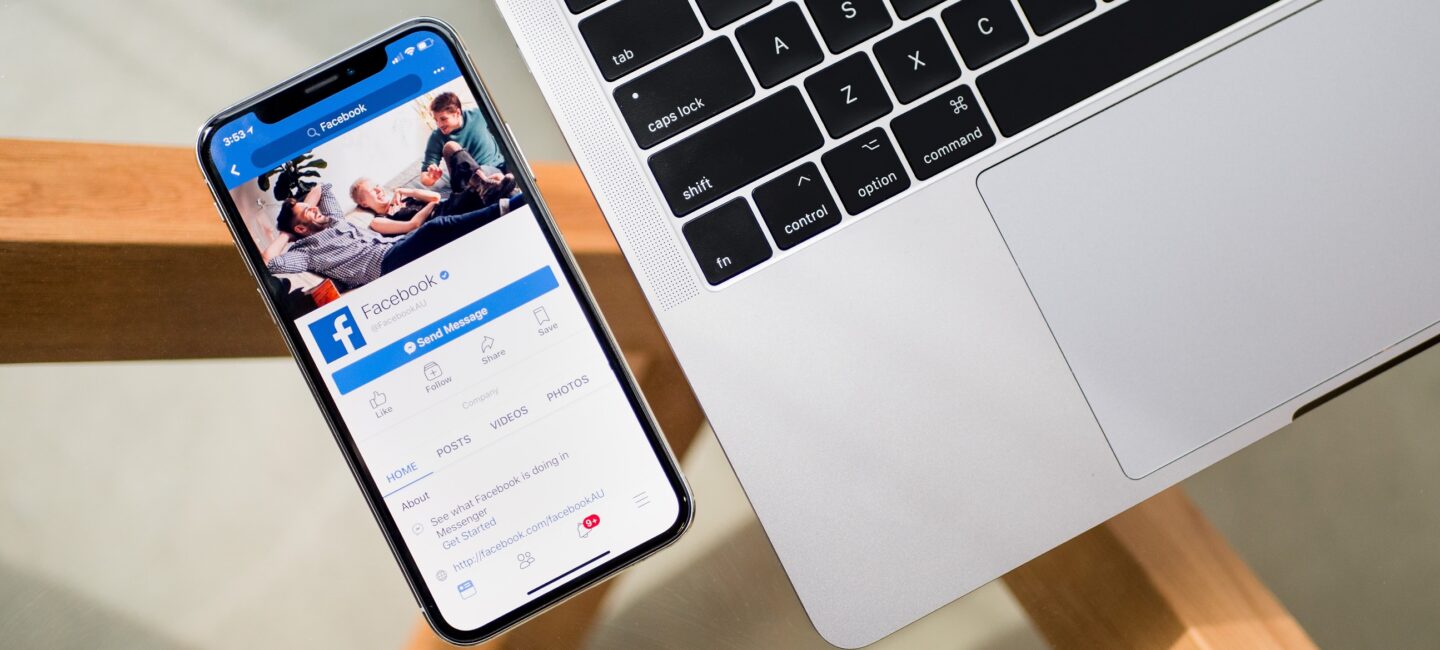Nine Ways Covid-19 Has Changed the Paid Media Landscape
From never leaving the house without a mask to now having to book your taxi home for 21:45 on the dot, Covid-19 has changed all of our lives enormously. The ways we work, socialise and travel have all been turned upside down, and how we consume media is no different.
Here, our paid media director, Emma Nicholls, discusses the nine ways the pandemic has affected the world of paid media, and the opportunities and challenges this presents for businesses.
1. The biggest losers are cinema and outdoor
Unsurprisingly, cinema and out-of-home have been hardest hit by the coronavirus pandemic. Recent news from Cineworld and Odeon means a recovery on that front won’t be expected until at least early spring next year, but there are deals to be had with out-of-home (OOH) media.
If you want to reach an audience that needs, or wants, life to return to some form of normality, don’t rule OOH out of your marketing mix. But do negotiate on price.
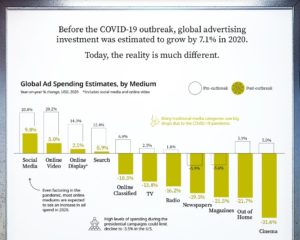
2. Paid media still works
Recent data from YouGov Profiles shows that close to four out of 10 Britons (38%) agree with the statement “advertising helps me choose what to buy”.
It is worth noting that such Britons are more likely than the general public to say they like brands that are willing to get involved in social issues (57% vs 44%), and are more inclined to purchase from a brand that expresses views they agree with in their adverts (62% vs 46%).
If ever there was a reason to get your paid media team talking to your creative and PR ones, this is it.
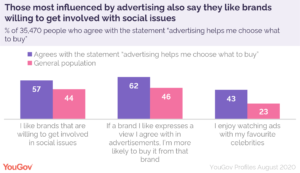
3. Trust in media has not declined, despite reports to the contrary
There has been much talk of consumer trust in the media being at an all-time low in Britain since the onset of the pandemic, but this is actually not the case.
For more than a decade, YouGov has, on a regular basis, asked the Great British public whether they trust different groups to ‘tell the truth’ – doctors, judges, teachers, police officers and estate agents, for example. Also included on this list are journalists, from both television news and newspapers.
In YouGov’s latest poll, conducted on 26 and 27 April 2020, 47 per cent of people expressed trust in BBC News journalists to tell the truth – actually up slightly from when the question was asked during the election campaigns of December 2019 (44%) and just a point below where it stood in March, before the government announced the lockdown (48%).
Trust in journalists for ITV and ‘upmarket’ newspapers has similarly been stable over the past six months.
So, despite news to the contrary, there has been no collapse in public trust in news media during the coronavirus outbreak. Good news for any business that has paid and earned media tactics at the heart of its marketing campaigns.

4. If trust matters, consider your target audience
One interesting outcome of YouGov’s recent trust-related poll, however, is the emergence of a notable partisan divide between voters.
Towards the end of the 2019 election campaign, trust in journalists for television news and upmarket newspapers was about the same, regardless of whether people supported the Conservative or Labour parties.
Since then, Labour voters have become more trusting of media, while trust has fallen fairly sharply among Conservative voters.
In fact, trust has been completely turned on its head for broadsheets. Traditionally, Conservative voters have tended to be more trusting of upmarket newspapers, but this is no longer the case; 46 per cent of Labour voters say they trust journalists from these papers but just 29 per cent of Conservative voters say the same.
Acknowledging these subtle shifts in some way could improve the performance of your paid media strategy.
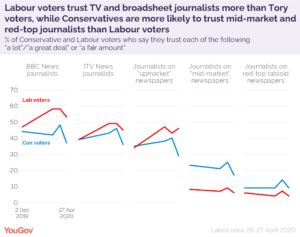
5. TV is where it is at
It probably goes without saying, but with most of us still spending more time at home than ever, TV is a hugely important part of the paid media mix – and not just because of reach.
Seventy per cent of Britons trust TV as a source of news and information, compared with just 28 per cent of us who have faith in social media channels.
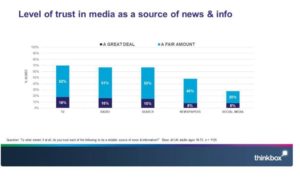
6. Lockdown habits remain in play
As could have been very easily predicted, the volume of TV viewing jumped significantly during lockdown – by 21 per cent according to BARB. However, even as lockdown rules were relaxed, our new TV viewing habits haven’t fallen by the wayside.
According to Thinkbox, shared TV viewing rocketed by 30 per cent over lockdown, “driven by the need to connect with others and find valuable points of reference during a period when our lives had shrunk”. For households that previously led quite separate lives, TV brought individuals together and helped them to develop new, shared routines – particularly for those forced to work from home and/or educate kids.
A real-time study following 12 households across the UK by Thinkbox showed that this bonding time around the TV was something participants said would stick even when lockdown ended, and over a third of the UK agreed that they would continue to watch programmes they had discovered since lockdown began.
The point here is if TV isn’t part of your paid media mix, now is really the time to be thinking about it. People trust TV more than ever and are watching it more than ever too.
Better still, for years many businesses thought TV advertising was out of their reach due to its mass appeal and associated costs. However, developments such as Sky AdSmart have changed that, making TV relevant and affordable for many more businesses across the UK.
For more information on Sky AdSmart, please get in touch. I’d be more than happy to help.
7. TV is surprisingly effective for reaching the baby boomer generation
Only 12 per cent of Brits who agree they are television addicts are aged between 18 and 24, compared with 21 per cent aged 25 to 34 and a staggering 32 per cent of those aged 55+. TV is a powerful way to reach most audiences, but is especially effective if you are seeking to target an older demographic.
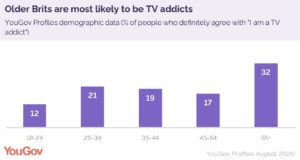
8. Getting the tone of your adverts right has never been more important
With life not likely to return to normal any time soon, reflecting the mood of the moment is vital if your paid media strategy is to be successful.
According to Thinkbox, “TV viewers want brands to show them a glimpse of the future, looking forward with positive lightheartedness and showing how new brand experiences will be enjoyable as well as safe”.
In one of its surveys, 41 per cent of people cited ‘a desire for positivity in ads’ and 35 per cent craved humour versus 31 per cent who wanted to see ‘normality’ and pre-lockdown life reflected.
We are already wondering what John Lewis is going to pull out of the bag this year.
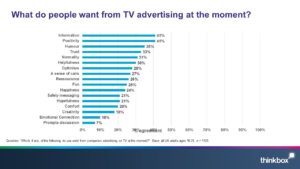
9. Podcasts are where we are seeing the fastest growth
Around 7.1 million people in the UK now listen to podcasts each week. That’s one in eight people – an increase of 24 per cent over the past year and more than double over the past five years. Ofcom research also found that half of listeners have joined the podcast wave in the last two years.
With the option to place ads at the beginning, end and middle of podcasts, they can be a very cost-effective way to reach a younger audience.
It is worth noting that for 18-54s, YouTube was the most popular service for accessing podcasts, while video podcasts on the platform are particularly popular with people aged 35-54. Among younger, regular listeners, podcasts with videos are the most popular choice, followed closely by BBC podcasts.
In summary, the paid media world looks just about as different as everything else in the world right now, but there is still a critical role for it in the marketing mix. Trust in the media is not in some sort of inexorable decline and close to 40 per cent of Britons admit that advertising helps them decide what to buy.
Trust in TV is especially high and new ways of advertising have opened it up to businesses who previously couldn’t dream of reaching such a mass market within the budgets available.
Reaching audiences on digital channels is more competitive than ever, so expect your costs per click and costs per view to have climbed accordingly. But don’t rule out OOH entirely, as there are some deals to be had.
Consider new means of targeting audiences too: podcasts, in-game advertising and the Facebook family of apps.
Above all, get your creative right. These are strange times and reflecting that, without dwelling on it, is the way to go according to consumer insight. It’s not an easy balance to strike, but is critical if you are to make the most of your paid media strategy over the coming weeks and months.
